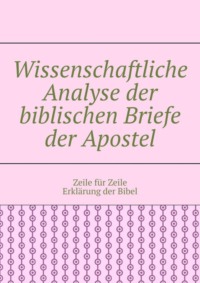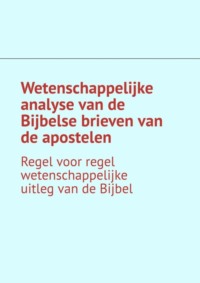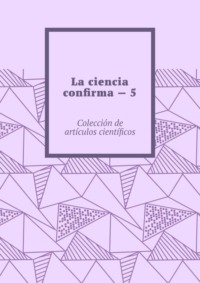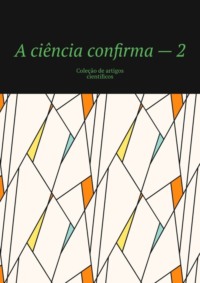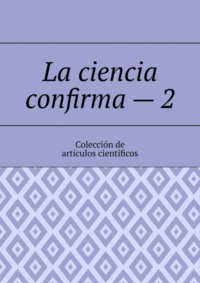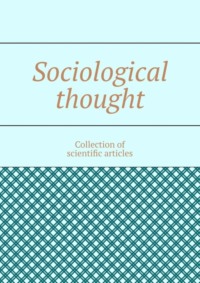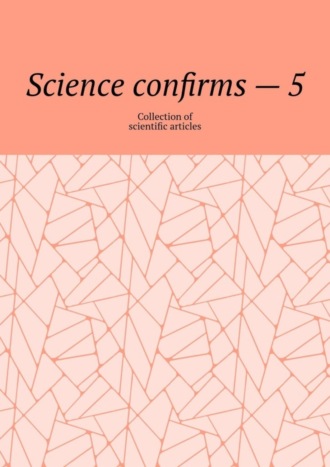
Полная версия
Science confirms – 5. Collection of scientific articles

Science confirms – 5
Collection of scientific articles
Editor Andrey Tikhomirov
ISBN 978-5-0059-6473-1 (т. 5)
ISBN 978-5-0059-4957-8
Created with Ridero smart publishing system
First money
Money is a means of carrying out exchange relations, a universal equivalent. In ancient times, the role of money was played by various goods (skins of animals, grain, cattle), gradually it passed to noble metals (gold, silver), which best meet the requirements of payment for goods. The Russian word “money” itself goes back to the Turkic “denga” and denotes the weight measurement of objects among the Mongols and Turks. There was a lot of money during the period of the Mongol yoke in Rus’, for example, Dmitry Donskoy, Vasily the Dark, Nizhny Novgorod, Novgorod-Severskaya, Pskov, Rostov, Ryazan, Starodub, Tver, Yaroslavl, etc. These coins were often minted in two fonts – Old Russian and Arabic.
For example, the Latin word pecunia – money comes from pecus – cattle. In the poems of Homer (VIII – VII centuries BC), the bull appears as a measure of value. Golden armor, for example, cost 100 bulls. Cattle were counted by head, and the Latin word caput – head was the basis of the modern words “capital”, “capitalism”. The word “cattle” denoted the concepts of money, property, wealth. Similarly, they were designated by the Anglo-Saxons – sceat, ready – skatts, in the ancient German language – skat. In Rus’, “cattle” is not only domestic animals, but also property, wealth, money. However, cattle was not the only type of money, and along with it, a wide variety of items served as ancient money: furs, skins, fabrics, various utensils, shells, beads and other jewelry, salt, fish, tea and many other items. Among the various types of primitive money, the shells of a small mollusk, mined in the Indian and Western Pacific Oceans, were especially popular – kauri. From ancient times and in a number of places until the 20th century. they were used as ornaments and were a means of exchange among many peoples of Europe, Asia, Africa and the Pacific Islands.
Furs were also very widely used as a general equivalent. This use of them in Ancient Rus’ is evidenced by some names of monetary units – kuna, veveritsa. In North America, furs were used as money as early as the beginning of the 18th century.
With the expansion of exchange to perform the function of a universal equivalent, a special commodity appeared, by its very nature most suitable for this purpose – noble metals. They very quickly forced out various types of non-metallic money from circulation. Initially, gold and silver were exchanged simply by weight in the form of bullion.
The transition from the use of money in the form of ingots of the most diverse form (bars, rods, rings, etc.) to minted coins was the result of an increase in production to a higher level, when exchange became vital for economically advanced countries and peoples.
Metal money practically did not deteriorate and could be stored as a treasure for an arbitrarily long time. In addition, having a large weight in a small volume, they greatly facilitated their transportation. Finally, they were easily divided into parts, turning into money of lesser value, which made it very easy to carry out small trading operations. In many countries, the circulation of various types of metallic money, primarily ingots, preceded the appearance of actual coins. In Greece, before the introduction of the coin, iron rods called obols were in circulation. Six rods made up a drachma (bundle, handful). Drachma subsequently became known as the ancient Greek silver coin. In ancient Italy, before the advent of coins, copper ingots served as money, in large numbers (about 300 kg) found in the healing sacred spring Aqua Apollinaris – Water of Apollo.
“Netherlands archaeologists, who studied the contents of many ancient treasures, came to the conclusion that bronze objects were used as the first money in Europe in the Early Bronze Age. The results of the study were published in the journal PLUS ONE.

© Photo: MHG Kuijpers Bronze strips, which served as the first money, from treasures in Central Europe
Scientists have long been trying to find out when the first money appeared and what it looked like.
One of the key features of money is its universality and standardization. Therefore, archaeologists are looking for large quantities of identical items in burials and treasures that could be used as currency.
Leiden University researchers Michael Kuijpers and Katalin Popa examined more than 5,000 artifacts from more than 100 Central European hoards dating back to the Bronze Age and assessed them for standardity.
The authors found that a number of bronze objects, in particular arcuate strips, bracelet rings and ax blades, were almost the same in many hoards – a person estimating their weight by eye would not notice the difference. Thus, the weight of 70 percent of the bronze strips found on the territory of modern Germany, Austria, the Czech Republic, Slovakia and Poland was about 195 grams.
Scientists believe that such items, completely standardized in shape and weight, played the role of the first money that circulated over a vast territory. The hypothesis is supported by the fact that archaeologists constantly find treasures containing many such homogeneous items.
In the southern part of Central Europe – in southern Germany, the Czech Republic and Austria – these are strips and rings, and in the north – in northeastern Germany and Poland – these are more axes. In central Germany, Bohemia and Moravia, all three types of objects are found.
In later finds dating back to the Middle Bronze Age in Europe, archaeologists often find, in addition to whole objects, their parts, both individually and fastened together, which, according to the authors, indicates the emergence of more accurate weighing tools and a more developed counting system involving fractional numbers.
“We hypothesize that the production of almost identical copies of rings, plates and ax blades and their use as commodity money led to a wider acceptance of weight standards and the emergence of a system of weights in Central Europe,” the authors of the article write.
At the end of the Bronze Age, artifacts made of gold appeared in the treasures, and the territory of distribution of standard bronze objects expanded to the north, to Scandinavia. Before that, they were present there only in single copies, in burials along with their alleged owners.
A metal hoop that was worn around the neck was called a neck hryvnia. It was made of iron, bronze, silver, less often of gold, known already in the Bronze Age. Later, among the Medes and Persians (Indo-Europeans of Iranian origin), noble men and women wore it. Among the Gauls (Indo-Europeans of Celtic origin), at first it was only a female adornment, then only a sign of the dignity of male leaders. Among the Romans (Indo-Europeans of Roman origin), the neck grivna (torques) served as an award awarded to legionnaires for military distinctions (honored soldiers had several hryvnias each). The neck torc was also part of the attire of noble men and women among the Scythians and Sarmatians (Indo-Europeans of Iranian origin) in the steppes of Eastern Europe, then spread among other peoples: among the Tissagets on the Kama, among the Sogdians and Khorezmians in Central Asia. In the Middle Ages, it had a similar meaning among the Western and Eastern Slavs (Indo-Europeans of Slavic origin), as well as among the Scandinavians and among a number of the Volga, Kama, Oka, and Baltic tribes. Russian combatants of the 10th-11th centuries. received a neck hryvnia as a reward. In the 12th-14th centuries. she served in Rus’ as a predominantly female adornment; it was also among the peasant women. Back in the 16th century. in Muscovite Rus’, it was part of the wedding attire of the nobility (both grooms and brides).

Neck grivna found in the Kursk region (Russia). 11th – 12th centuries Great Soviet Encyclopedia, 2nd ed., editor-in-chief B. A. Vvedensky, vol. 12, 1952, p. 597
The hryvnia is a silver ingot that served as a monetary and weight unit in Ancient Rus’. The weight hryvnia corresponded to one pound (96 spools – 409.512 g). The monetary hryvnia was called the hryvnia kun and corresponded to the 12th century. 96 spools of silver or an equivalent number of valuable furs, Russian and foreign coins circulating in Rus’. In the 12th century all units of the kuna system, including its main unit – the hryvnia, without changing their nomenclature, decreased in weight by half, and the silver hryvnia, turning into an ingot weighing about 48 spools (204.756 g), separated from the hryvnia kuna. The latter, as a monetary unit for valuable furs and foreign coins, was in circulation on the outskirts of Rus’ until the 14th century. The all-Russian monetary hryvnia looked like an oblong ingot of silver. In Kievan Rus until the beginning of the 13th century. also had circulation, the Kiev hryvnia (a hexagonal ingot of silver weighing 38 spools), equal to half the Byzantine liter and used mainly in relations with Byzantium. Novgorod, Chernihiv and other grivnas also differ. During the 13th and 14th centuries the weight of the hryvnia continued to decline, reaching by the end of the 14th century. about 184. From the 2nd half of the 13th century. a silver ingot appeared, corresponding to half of the monetary hryvnia – the ruble (from the word “cut”, in the 13—14 centuries, for the convenience of trading calculations, the hryvnia began to be cut into pieces, each part became known as the ruble), which in the 15th century. finally supplanted the monetary hryvnia. Since the 14th century, Russian coins have often depicted a horseman with a spear, the prototype of which was George the Victorious, later from here arose – a penny 1/100 of the ruble. Also in the 14th and 15th centuries on the territory of Rus’, controlled by the khans of the Golden Horde, payment bars were used – Tatar soms (sums), the name goes back to the weight tradition of the Horde. From the 16th century The hryvnia became the monetary unit of account. They called the hryvnia, a real ingot of silver; unit of mass; as well as countable hryvnia, when hryvnias coexisted with coins in monetary circulation. The names of many modern currencies (for example, mark, pound, lira) contained concepts of this kind. At the very beginning of the formation of the monetary system, the three hypostases of the hryvnia coincided with each other, but under the influence of internal and external factors, the values began to diverge. For example, as a result of the saturation of the market with minted coins, the demand for it fell. The weight of the ingot hryvnia also varied depending on the period and region.

1 – hryvnia of the Novgorod type. 12th-13th centuries; 2 – hryvnia of the Kyiv type. 12th century; 3 – hryvnia of the Chernihiv type. 12th century, ibid.
On the territory of the ancient Russian state, ingots of various weights and types circulated, but the so-called Kyiv and Novgorod hryvnias prevailed. Kyiv hryvnias XI – XIII centuries. are cast ingots of a hexagonal shape. Throughout the entire period of their existence, they maintained a stable weight of about 160 g. This allows us to associate their weight norm with the weight of the Byzantine liter -327.456 g and consider it equal to 1/2 liter 163.728 g.
The general dating of the Kyiv hryvnia confirming joint finds with Byzantine coins of the 11th-12th centuries. They appeared, most likely, in the middle of the XI century. and existed until the Mongol-Tatar invasion. Their range covers almost the entire territory of Kievan Rus, but most of the finds are concentrated in its southern regions.
Novgorod hryvnia ingots had a completely different look and weight. These are long sticks weighing about 200 g. There are two types of Novgorod ingots: longer (14—20 cm) and straight and short (10—14 cm) with a slightly curved back. The first date from the 11th-13th centuries, the second – from the 14th-15th centuries.
Unlike Kyiv ingots, Novgorod hryvnias provide a relatively large amount of epigraphic material – they are often scratched with the names of the persons for whom they were cast. From one such inscription, one of the Russian names for the ingot itself became known – “izroy” (from the word “dig up”). Sometimes on Novgorod ingots there are scratched transverse lines, the last of which, as a rule, is oblique.
In addition to these two main types of silver ingots – Kiev and Novgorod, some others also participated in the monetary circulation of Ancient Rus’, for example, the so-called Chernigov, close in weight to Novgorod, and in shape representing, as it were, roughly flattened Kiev, or Lithuanian – in the form of small sticks of soft outline, often with several characteristic dents on the back. Metrologically, Lithuanian ingots are not connected with Russian weight systems and came to Rus’ from the Baltic states as silver raw materials.
Since in Rus’ coins were the main original form of silver raw materials, a certain number of coins of the same weight could well serve as a measure of the weight of an ingot – hryvnia. Then, apparently, a feedback was established – a silver bar began to serve as a measure of the number of coins. Most likely, it was as a result of this connection between coins and ingots that such monetary and weight concepts as “hryvnia” (weight unit), “hryvnia silver” (ingot) and “hryvnia kun” (counting unit) were developed. Written sources make it possible to establish the weight equality of hryvnia silver to 4 hryvnia kunas and calculate the weight values of fractions of the latter.
Old Russian monetary terminology and money account. In Russian written sources, primarily in Russian Pravda and the Tale of Bygone Years, the following names of monetary units are contained: cattle, kuna (from “marten”), rezana (from “cut”), nogata (from Arabic naqd – a full-fledged, perfect coin), a veveritsa (from the old Russian “squirrel”, Polish wiewiórka, the smallest monetary unit), veksha (a valuable good-quality fur), white (apparently, white fur) and hryvnia.
The oldest unit of weight is the hryvnia. This name is associated with a neck decoration in the form of a hoop, which is widespread among the Slavs, Finno-Ugric peoples and other peoples. The origin of the weight hryvnia has not yet been finally established. Attempts were made to derive its weight from the Byzantine liter (Roman libra – 327.456 g) on the basis of a parallel analysis of the 911 agreement between Rus’ and Byzantium and Russian Pravda. The agreement fixes a fine of 5 liters for intentionally striking “according to Russian law”, and Russkaya Pravda imposes a fine of 12 hryvnias for a similar insult. From here, the weight of the hryvnia was determined at 136.44 g.
Конец ознакомительного фрагмента.
Текст предоставлен ООО «ЛитРес».
Прочитайте эту книгу целиком, купив полную легальную версию на ЛитРес.
Безопасно оплатить книгу можно банковской картой Visa, MasterCard, Maestro, со счета мобильного телефона, с платежного терминала, в салоне МТС или Связной, через PayPal, WebMoney, Яндекс.Деньги, QIWI Кошелек, бонусными картами или другим удобным Вам способом.




